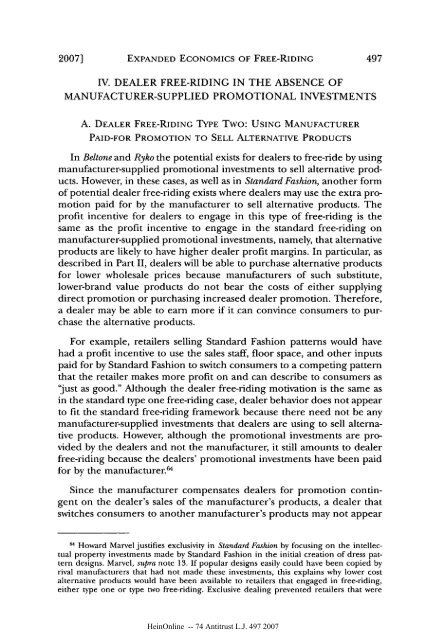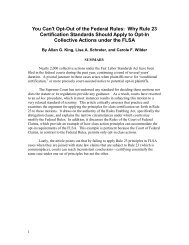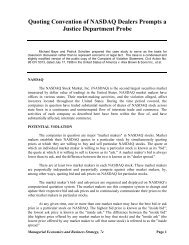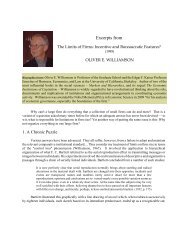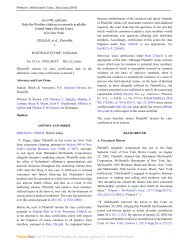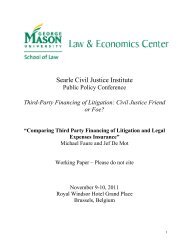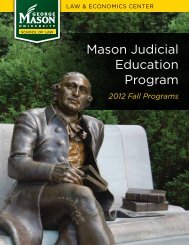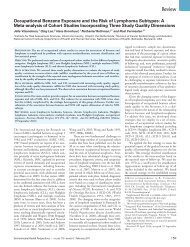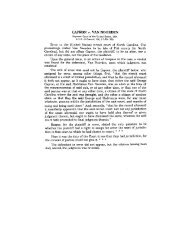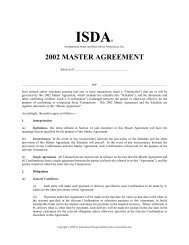Klein and Lerner, âThe Expanded Economics of Free-Riding: How ...
Klein and Lerner, âThe Expanded Economics of Free-Riding: How ...
Klein and Lerner, âThe Expanded Economics of Free-Riding: How ...
You also want an ePaper? Increase the reach of your titles
YUMPU automatically turns print PDFs into web optimized ePapers that Google loves.
20071EXPANDED ECONOMICS OF FREE-RIDINGIV. DEALER FREE-RIDING IN THE ABSENCE OFMANUFACTURER-SUPPLIED PROMOTIONAL INVESTMENTSA. DEALER FREE-RIDING TYPE Two: USING MANUFACTURERPAID-FOR PROMOTION TO SELL ALTERNATIVE PRODUCTSIn Beltone <strong>and</strong> Ryko the potential exists for dealers to free-ride by usingmanufacturer-supplied promotional investments to sell alternative products.<strong>How</strong>ever, in these cases, as well as in St<strong>and</strong>ard Fashion, another form<strong>of</strong> potential dealer free-riding exists where dealers may use the extra promotionpaid for by the manufacturer to sell alternative products. Thepr<strong>of</strong>it incentive for dealers to engage in this type <strong>of</strong> free-riding is thesame as the pr<strong>of</strong>it incentive to engage in the st<strong>and</strong>ard free-riding onmanufacturer-supplied promotional investments, namely, that alternativeproducts are likely to have higher dealer pr<strong>of</strong>it margins. In particular, asdescribed in Part II, dealers will be able to purchase alternative productsfor lower wholesale prices because manufacturers <strong>of</strong> such substitute,lower-br<strong>and</strong> value products do not bear the costs <strong>of</strong> either supplyingdirect promotion or purchasing increased dealer promotion. Therefore,a dealer may be able to earn more if it .can convince consumers to purchasethe alternative products.For example, retailers selling St<strong>and</strong>ard Fashion patterns would havehad a pr<strong>of</strong>it incentive to use the sales staff, floor space, <strong>and</strong> other inputspaid for by St<strong>and</strong>ard Fashion to switch consumers to a competing patternthat the retailer makes more pr<strong>of</strong>it on <strong>and</strong> can describe to consumers as'just as good." Although the dealer free-riding motivation is the same asin the st<strong>and</strong>ard type one free-iding case, dealer behavior does not appearto fit the st<strong>and</strong>ard free-riding framework because there need not be anymanufacturer-supplied investments that dealers are using to sell alternativeproducts. <strong>How</strong>ever, although the promotional investments are providedby the dealers <strong>and</strong> not the manufacturer, it still amounts to dealerfree-iding because the dealers' promotional investments have been paidfor by the manufacturer. 64Since the manufacturer compensates dealers for promotion contingenton the dealer's sales <strong>of</strong> the manufacturer's products, a dealer thatswitches consumers to another manufacturer's products may not appear64 <strong>How</strong>ard Marvel justifies exclusivity in St<strong>and</strong>ard Fashion by focusing on the intellectualproperty investments made by St<strong>and</strong>ard Fashion in the initial creation <strong>of</strong> dress patterndesigns. Marvel, supra note 13. If popular designs easily could have been copied byrival manufacturers that had not made these investments, this explains why lower costalternative products would have been available to retailers that engaged in free-riding,either type one or type two free-riding. Exclusive dealing prevented retailers that wereHeinOnline -- 74 Antitrust L.J. 497 2007


